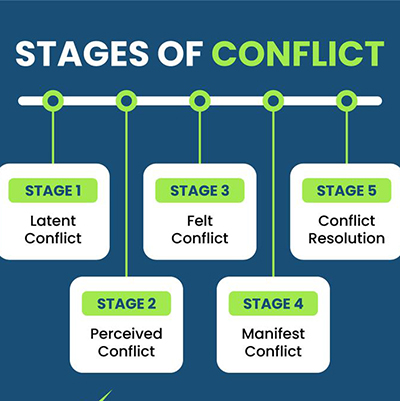Stages of conflict refer to the process and development of conflicts within organizations. Both employees and organizational units contribute to tensions, but they also face pressure due to systemic constraints (conflict causes). The emergence of conflict fields encompasses all variables relevant to the conflict and their interrelationships. These fields can be categorized into content and dynamic aspects.
Content Aspects of Conflict Fields
-
Substantive Conflicts
These occur on the factual-intellectual level and involve disagreements regarding the nature of tasks, how they should be evaluated, the methods to achieve goals, or differences in the information available to the conflicting parties. Substantive conflicts are usually focused on work performance and, when handled appropriately, can lead to constructive discussions. -
Socio-Emotional Dimension
This aspect concerns the interpersonal relationships and emotions of the parties involved in the conflict. Emotional reactions such as mistrust, dislike, hatred, or even sympathy can develop alongside the factual issues. These emotions can either escalate or ease the conflict and affect future interactions. Destructive outcomes are often more common at this stage. -
Value-Based Cultural Dimension
Conflicts in this dimension stem from differences in value systems within the company. These values are shaped by the beliefs and priorities of groups, individuals, and leadership. Conflicts often arise when there are differing or conflicting value systems, and these are usually deeply rooted, making them harder to resolve. Destructive effects are also likely at this level.
Interdependencies of Conflict Dimensions
Most conflicts encompass elements from all three dimensions. These levels influence each other, either escalating the conflict (e.g., growing antipathy) or bringing about balance (e.g., growing sympathy). Conflicts can even be transformed—personal disputes or factual disagreements may stem from underlying differences in value systems.
« Back to Glossary Index





![15 Employee Offboarding Templates That Save Hours of HR Time [Free Downloads] 15 Employee Offboarding Templates That Save Hours of HR Time [Free Downloads]](https://i1.wp.com/www.hrcloud.com/hubfs/Header.png?w=150&resize=150,100&ssl=1)
